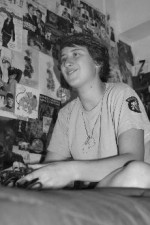Sabbatical cures prof’s ‘wanderlust’
I have always had a nomadic nature. My father used to call it “wanderlust,” and worried I would never settle down. Well, after 22 years teaching at Castleton, I guess I am pretty settled, but I learned early on that settling down does not mean one needs to abandon an adventuring spirit. The spirit of adventure is a driving force for intellectual, artistic, physical and travel pursuits. It is at the core of learning and living and certainly informs my own teaching and artistic endeavors.
For me, traveling to new places and in new ways is both challenging and nourishing. When I decided to apply for a sabbatical last year, I knew that it would be important to use the year well, not only to refocus and renew my disciplinary knowledge, but to let myself journey in new directions with an open sense of discovery.
One of the most basic laws of Newtonian physics is that “An object that is at rest will stay at rest unless an unbalanced force acts upon it.” I am not sure if “wanderlust” is some sort of chemical imbalance in the brain, but I do know that for most of the past five months I have been in almost constant motion.
During the summer months, my wife Dawn Saunders (who teaches economics at CSC) and I sailed our 20′ foot boat from Vermont to North Carolina. Dawn and I moored at numerous ports along the way, wandering about towns and cities that for many might only be highway signs flashing by on the interstate. There is something inspiring about seeing this country at the pace of the wind and tides from a few yards or a few miles off the shores that cannot be adequately expressed or measured in words.
Berthing in a marina in Norfolk, Va., I took a break from the passage and spent just under two weeks in Australia, attending and presenting at an arts conference as well as taking in the varied works at the Sydney Biennale. Although I have been to many other international arts conferences over the years, the unique nature of Australia’s history and geography, and in particular the cultural influences of the indigenous peoples on the art and politics of country, has actually led me to rethink many of my own assumptions about American and European art.
While in Australia, I also took a train trip to Katoomba and spent three days hiking in the Blue Mountains as well as exploring the Jenolan caves. The splendor of these mountains blanketed in the blue Eucalyptus mist of a winter morning, and the intricate sculptural formations in the caves were certainly works of art unequaled in any museum or gallery.
In September, I joined the Castleton students studying at Roehampton University for the orientation and initial weeks. When I was not working with the students, I did my usual London thing of walking about town and spending hours on end in museums and galleries. I have been to London many times over the past 30 years, and each time I notice how the city, despite its long and complex history, is always in flux. It is not just that buildings and fashions change, but the city itself seems to hum with the energy of a specific moment in time.
I left London and headed off for three weeks in Crete, the southernmost of the Greek Islands, and in many ways a little country/continent in its own right. I have long had a fascination with Cycladic and Minoan history and art and Crete is rich in archeological and cultural sites. It is also a wonderful place just to sit back and watch the sunset after day of hiking on the beach or exploring fragments of human civilizations dating back thousands of years.
One of the standout moments in Crete, and tribute to both Castleton’s reach and the smallness of the world, was meeting up with my colleague, professor Harry Chaucer in the lobby of a small hotel in the city of Heraklion. Harry is also on sabbatical and had been traveling in Europe doing research on Leonardo DaVinci.
Harry was nearing the end of his travels when he and his son wandered into the hotel late one evening. I just happened to be in the lobby checking e-mail and chatting with the receptionist. Harry and I did a couple of classic slow motion double-takes, shared a laugh and then spent the next day together driving down to Matala and exploring the archeological dig at the Palace of Festus in southern Crete.
After admiring the ruins, we headed down to a beachside taverna for lunch and spent some time checking out the hillside caves. The caves were once Roman crypts, but are most famous as homes for hippies in the 60s, and a lyric or two in the lives of Cat Stevens and Joni Mitchell. Harry left me (in a hotel not a cave) in this veritable paradise for four nights with my watercolors, camera and notebook. Then I spent another 10 days in various other towns and villages on the island shooting photos, writing and just wandering about. Ah, life’s just tough sometimes.
After Crete, I went back to London for a quick meeting with the students, and then off to the south of France to visit my uncle, a semi-retired, well-known modern dance choreographer. While there, I found myself suddenly and significantly involved in a professional capacity working on a dance video and book project with a BBC producer, a few dance professors, my uncle and others. If all goes well, that project may require my returning to London and France in the summer. More immediately, I plan to leave next week to spend the remainder of the year and spring semester working on other projects while cruising in my boat on southern waters. But those are just the seeds of other stories yet to bloom during this ongoing sabbatical adventure.





